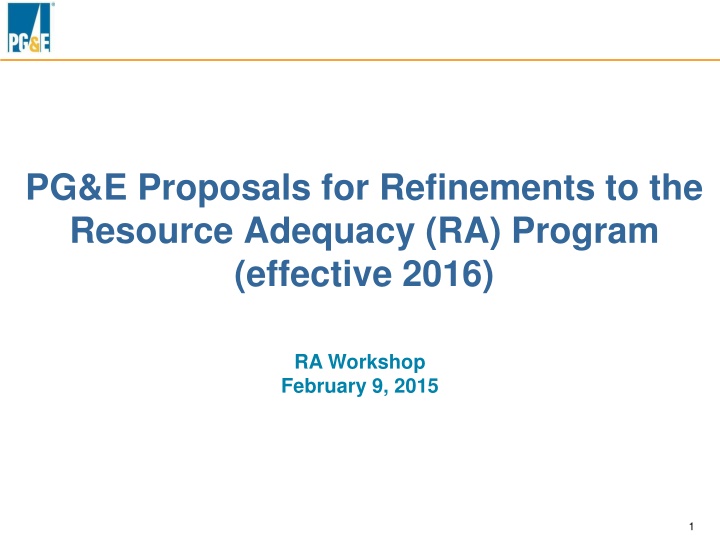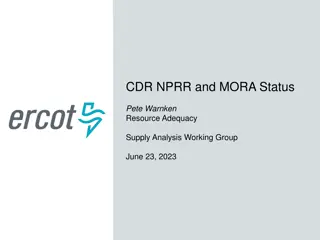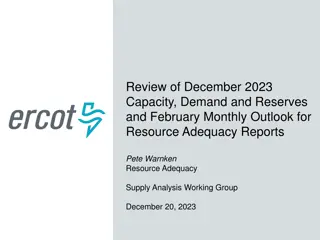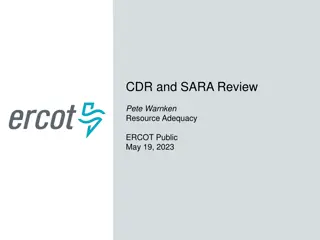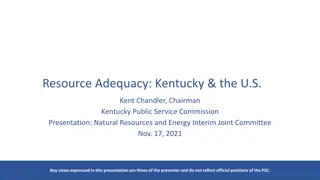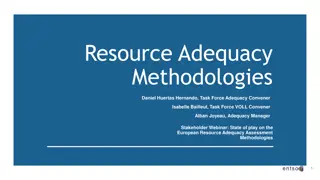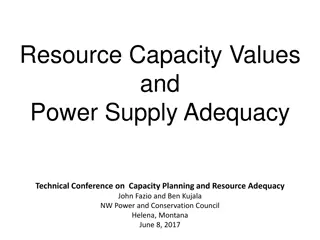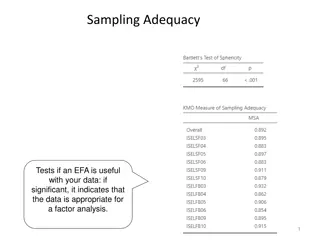PG&E Proposals for Refinements to Resource Adequacy Program
PG&E presents proposals to enhance the Resource Adequacy Program, focusing on modifications to QC and EFC methodologies for storage resources. The proposals aim to promote fair valuation, prevent over-procurement, and reduce costs for customers. The plans include equal treatment for storage resources and modifications to QC calculations for resources capable of day-ahead scheduling. The effectiveness of hypothetical storage resources in reducing ramping needs is also illustrated.
Download Presentation

Please find below an Image/Link to download the presentation.
The content on the website is provided AS IS for your information and personal use only. It may not be sold, licensed, or shared on other websites without obtaining consent from the author.If you encounter any issues during the download, it is possible that the publisher has removed the file from their server.
You are allowed to download the files provided on this website for personal or commercial use, subject to the condition that they are used lawfully. All files are the property of their respective owners.
The content on the website is provided AS IS for your information and personal use only. It may not be sold, licensed, or shared on other websites without obtaining consent from the author.
E N D
Presentation Transcript
PG&E Proposals for Refinements to the Resource Adequacy (RA) Program (effective 2016) RA Workshop February 9, 2015 1
Modifications to QC and EFC Methodologies 2
PG&E Proposal to Modify the Effective Flexible Capacity (EFC) Calculation for Storage Resources with Non-Zero Transition Periods Under the current flexible RA counting rules, storage resources with a non-zero transition time between charge and discharge can only count their discharge capacity towards their EFC value, despite the ability of these resources to provide flexibility by charging. Problem Statement The Commission should modify the flexible RA counting rules for storage resources to include the full range of charge and discharge that a storage facility can achieve and sustain over a three-hour period, so long as the resource s transition time between the two states is less than 45 minutes. Proposed Solution Equal treatment for all storage resources Fair valuation of all existing and potential storage resources (storage RFOs) Helps prevent over-procurement Reduces costs to customers Justification for Proposal 3
The Flexible Contribution of a Hypothetical 1,000 MW Storage Resource with a 45-Minute Transition Time Typical Winter Day in 2020 Gross Load Average Gross and Net Load Winter 2020 Forecast (Jan-May, Oct-Dec) Wind 40,000 Solar 35,000 Net load With 500 MW x2 (1000 MW Total) Pumped Storage Project (PSP) 30,000 Load in MW 25,000 Reduces ramp by 1,000 MW when discharging 20,000 Reduces ramp by 1,000 MW when charging 15,000 Total Reduction in upward ramp: 2,000 MW 10,000 5,000 1 2 3 4 5 6 7 8 9 10 11 12 13 14 15 16 17 18 19 20 21 22 23 24 Hour Ending Key Takeaway: A storage resource with a non-zero transition period reduces ramping needs in the same manner as a storage resource with a zero transition period. 4
PG&E Proposal to Modify the Qualifying Capacity (QC) Calculation for Resources That Can Be Scheduled in Day-Ahead and Pre-Day-Ahead Timeframes There is a disincentive to re-structure contracts to provide additional operational flexibility under the current RA rules because doing so results in lower QC values Problem Statement The Commission should modify the system and local RA counting rules for resources that are capable of operating in accordance with day-ahead and pre-day- ahead scheduling instruction, but are not fully capable of responding to real-time dispatch instructions, so that the QC values for such resources are equal to Pmax, rather than based on historical output. Proposed Solution Recognize the QC value of a resource that can be scheduled to its Pmax when the CAISO finds it beneficial to do so Provide more operational flexibility to the CAISO Help address potential over-generation conditions by creating an incentive to operate flexibly Helps prevent over-procurement Reduces costs to customers Justification for Proposal 5
Decrease in QC for a QF Unit Resulting from Conversion to Pre- Scheduled Operation Change in NQC Over Time 30 Average NQC Value (MW) from Final NQC 25 NQC values based upon 3-year historical meter data decrease as the resources run only when economic conditions support operation. 20 15 Report 10 5 PG&E Contracted Unit 1 PG&E Contracted Unit 2 0 2011 2012 2013 Year 2014 2015 Contracts renegotiated with additional operational flexibility Key Takeaway: Resources able to be pre-scheduled or economically dispatched on a day-ahead basis (but unable to be fully dispatched in real-time) are penalized under the QC calculation for providing additional operational flexibility. 6
PG&E Proposal on QC Manual Update The Commission s QC methodology manual has not been updated since its initial adoption in 2010, despite a number of refinements to the QC methodologies being adopted by the Commission since that time. Problem Statement The Commission should complete a comprehensive update of the QC methodology manual following the anticipated June 2015 RA decision. Proposed Solution Provides a single source of information for the current QC methodologies. Provides an opportunity to provide more detail and clarity on the methodology used by Energy Division to calculate QC values. Justification for Proposal 7
Flexible Capacity Requirements Allocation 8
PG&E Proposal to Modify the CPUCs Flexible RA Requirements Allocation Methodology The current CPUC methodology used to allocate flexible RA requirements does not reflect cost causation because it is based on load ratio share rather than the load-serving entity s (LSE) contribution to the largest 3-hour ramps. Problem Statement The Commission should modify the methodology for allocating flexible RA requirements to its LSEs so that the flexible RA requirements are allocated in proportion to the LSEs contributions to the CAISO s monthly net- load ramps used to determine the overall flexible RA requirement. Proposed Solution Better reflects cost causation Aligns the Commission s and the CAISO s allocation approaches Sends better market signals to developers and LSEs Justification for Proposal 9
Appendix 10
Charge and Discharge Level at Helms Pumped Storage Plant: 2013 Through Q3 2014 Key Takeaway: Helms operates flexibly in both directions (charge and discharge) on a nearly daily basis. 11
The Flexible Contribution of a Hypothetical 1,000 MW Storage Resource with a 45-Minute Transition Time Typical Summer Day in 2020 Average Raw and Net Load Summer 2020 Forecast (Jun-Sep) Raw load Wind 40,000 Solar Net load With 500MWx2 PSP 35,000 Reduces ramp by 1,000 MW when discharging 30,000 Load in MW 25,000 Reduces ramp by 1,000 MW when charging 20,000 Total Reduction in upward ramp: 2,000 MW 15,000 10,000 1 2 3 4 5 6 7 8 9 10 11 12 13 14 15 16 17 18 19 20 21 22 23 24 Hour Ending Key Takeaway: A storage resource with a non-zero transition period reduces ramping needs in the same manner as a storage resource with a zero transition period. 12
